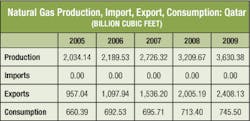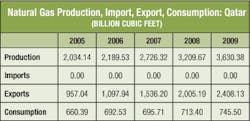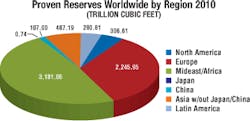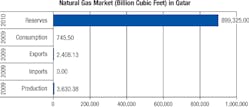It’s a hot time for oil and gas measurement. Two events have occurred in the past several years that make this so – the price of a barrel of oil has increased to over $100 a barrel; and many analysts now see natural gas as a solution to high oil prices and diminishing oil supplies. Natural gas is more plentiful than oil both in the United States and in many countries worldwide. It is a cleaner burning fuel than oil, with fewer environmental effects. And natural gas is being touted by some as a bridge to renewable energy sources, such as solar and wind.
Renewables may be the ultimate solution to the world’s thirst for energy, but currently they are more expensive than fossil fuels, and the technologies are still in the early stages of development. This will change over time, but making solar, wind, geothermal, biomass, and other types of renewable energy competitive price-wise with oil and natural gas may take many years.
Anyone who follows the world energy market is confronted with a confusing array of terms and measurement units. Oil is measured in barrels, while natural gas is measured in cubic feet, sometimes in billions or trillions of cubic feet. There are many types of natural gas, such as dry natural gas, liquefied natural gas (LNG), compressed natural gas (CNG), and synthetic natural gas. On the liquid side, there are natural gas liquids (NGL), gasoline, and lease condensate. There are different types of crude oil, and these oils sell at different prices. West Texas Intermediate (WTI) and Brent are the two most popular benchmark crude oils, but there are many other types as well. When most people refer to “the price of crude oil,” they are referring to one of these two types.
Why Oil Is Measured in Barrels
Oil is commonly measured in 42-gallon barrels. This convention goes back to the original discovery of oil by Edwin Drake in Pennsylvania in 1859. At that time, the 40-gallon whiskey barrel was a common means of storing large amounts of liquid. It is believed that the extra two gallons were added to the 40-gallon barrel because some shrinkage of water is possible during settlement. Adding the extra two gallons insured that at least 40 gallons of oil arrived at the refinery. The convention of abbreviating barrels of oil as “bbl” comes from “blue barrel.” Kerosene at the time was stored in blue drums and gasoline in red drums, and the convention became to abbreviate oil barrels as “bbl.”
Even though the unit of measurement for oil is the 42-gallon barrel, it is not commonly transported today in barrels. The technology of oil transportation has moved far beyond this method. Instead, oil today is moved today in trucks, pipelines, trains, and ships. When oil is transported in trucks and ships, it is stored in very large containers, not in barrels, even though the 42-gallon barrel still remains the unit of measurement.
There are more than 900,000 wells in the world that produce both oil and gas, and they produce about 85 million barrels per day in oil. Oil wells on land are typically referred to as “topside” well. Other wells are located offshore and in subsea locations. Over half the wells worldwide are located in the United States, but this does not correlate to the total amount of production. Typically offshore and subsea wells produce larger quantities of oil than topside wells. In reality, the United States produces about eight percent of the world’s oil, while it consumes close to 25 percent of the world’s total on a daily basis. This is why the United States is so dependent on foreign oil; the country has to rely on foreign oil to make up the difference between oil produced and oil consumed.
Proved Reserves – Potentially Recoverable Oil
While the amount of oil produced worldwide on a daily basis is of interest, the amount of proved oil reserves is also important. Oil reserves represent oil that can be recovered with reasonable certainty under current economic and operating conditions. Thus, the amount of proved reserves can change over time as recovery technology improves. According to the Oil and Gas Journal, there were about 1.3 trillion barrels of proved oil reserves worldwide at the end of 2009.
The concept of proved oil reserves is important because it represents the total amount of potential recoverable oil worldwide under current economic and technological conditions. Proponents of the “peak oil” theory argue that the world has already reached, or will soon reach, its maximum worldwide production, and that production over the long term will decrease. They point to the declining production in the oil fields of Mexico and the reduced production in the North Sea. On the other hand, Petrobras is continuing to make new offshore oil discoveries off the coast of Brazil, and there is a great deal of untapped oil in the ground in the United States, especially in offshore locations. While there is no doubt that the amount of oil the world is capable of producing will decline in the long term, analysts differ about how quickly this decline will begin.
Light or Sweet? Heavy or Sour?
Oil is a little like syrup; there are different types of syrup and they are used for different purposes. For example, there is chocolate syrup, caramel syrup, maple syrup, and corn syrup. The main distinctions in oil are between light and heavy and between sweet and sour. Light oil is less dense than heavy oil and can be distilled into refined products at temperatures below 700 F. Heavy oil, by contrast, distills at temperatures above 1,050 F.
Sweet crude has a lower sulfur content than sour crude, typically less than 0.5 percent. Sour crude, by contrast, is higher in sulfur content, often between 3 percent and 4 percent. The best oil for refining purposes is light sweet crude, and it comes from Norway, Libya, Nigeria, and the United Kingdom, among other countries. Saudi Arabia and Russia are known for their medium sour crude oil. Heavy sour crude comes from Venezuela and Canada. Brazil is known for heavy, medium sour crude.
What About Natural Gas?
The unit of measurement for natural gas is not as intuitive as it is for oil. Natural gas is measured by volume and is stated in cubic feet. A cubic foot is a cube with equal sides of one foot each. A cubic foot of natural gas is the amount of gas it takes to fill a volume of one cubic foot under set conditions of pressure and temperature.
There are several reasons why the units for measuring natural gas are less intuitive than those for oil. One is that most people are familiar with the volume of a gallon, at least on non-metric countries, and the amount of oil in a barrel is stated in terms of the number of gallons. In addition, the concept of a cubic foot itself is less intuitive than that of a gallon, and since gas expands as it is heated, the volume of gas in a cubic foot has to be stated relative to temperature and pressure conditions.
The biggest problem with understanding how natural gas is measured is that the amounts of natural gas in terms of production and reserves are very large, and the unit of measurement is quite small. The effect would be similar for oil if oil were measured in pints instead of barrels, or even in square inches. For example, here are some actual figures from the Energy Information Administration (EIA) for reserves, production, imports, exports, and consumption for Qatar, which has the world’s third largest natural gas reserves.
In order to show natural gas production and reserves on the same scale, it is necessary to show reserves in thousands of billions of cubic feet, which is actually trillions of cubic feet. So, in 2010, Qatar had proved reserves of about 899 trillion cubic feet. This is a huge number, and it is a little reminiscent of recent discussion on the U.S. national debt.
Regardless of how it is measured, the proved reserves of natural gas worldwide are far greater than those of oil, and the supplies of natural gas will outlast oil supplies by decades, or potentially for more than a hundred years. This is why there is such a push to move towards natural gas as a source of fuel, including the use of compressed natural gas (CNG) as a source of fuel for automobiles and trucks. Natural gas is cleaner and more abundant than oil, and it can do the same job as oil in terms of providing energy in many situations.
While renewable fuels still remain a long-term solution to the world’s energy demands, natural gas is a reliable and relatively inexpensive alternative to oil, and it can be a bridge to renewable fuels. Even though its quantities may be hard to grasp, that is partly because they are so large, and that is good for the world, and especially good for the world of energy.
Jesse Yoder, Ph.D., is president of Flow Research Inc. in Wakefield, Mass., a company he founded in 1998. He has 23 years of experience as an analyst and writer in process control. Yoder specializes in flowmeters and other field devices, including pressure and temperature products. He has written over 120 journal articles on instrumentation topics. Dr. Yoder can be reached at jesse@flow research.com.
Flow Research is currently working on a cluster of six studies called “The World Market for Gas Flow Measurement, 2nd Edition” – www.gasflows.com.






